Snakes are diverse creatures found in almost every part of the world. Their diversity not only includes their habitats, behaviors, and venoms but also extends to their appearances. Typically their colors work as an advantage for them to predate or hide from predators themselves by camouflaging. Some snakes, however, take on breathtakingly beautiful colors and are a sight for sore eyes. Today, we’ll be talking about 30+ interesting blue and black snakes.
Blue snakes aren’t all that common in nature. Most cases of blue-skinned snakes are because of mutations that cause them to diversify from their species’ natural color. However, there are also some species that are naturally blue. In this article, we’ll get into details for 10 uncommon blue and black snakes and then list the rest.
30+ Interesting Blue and Black Snakes
1) Blue Malayan Coral Snake
Blue Malayan Coral Snakes are an enchantingly beautiful species of snakes native to Southeast Asia. The skin of this species is a vibrant, shimmering blue that changes to bright orange on the ventral side, covering its small head.
They are a venomous species and have unusually long venom glands. Their venoms have been the cause of a few human deaths, but it doesn’t contain a neurotoxin.
- Common Name: Blue Coral Snake
- Scientific name: Calliophis bivirgatus
- Size: 180 centimeters (5.11 feet)
- Location: Brunei, Burma, Indonesia, Malaysia, Singapore, Thailand
2) Vietnamese Blue Beauty Rat Snake
The next on this list of blue and black snakes are the Vietnamese Blue Beauty Rat Snake. The natural color of the Beauty Snake is yellowish-brown to olive, but there’ve been several blue-colored specimens observed.
The blue-skinned snakes have blue as the background color, with a paler blue in the continuous and discontinuous patterns over the body. The small areas around their eyes are a blue-black color. This nonvenomous species is currently considered Vulnerable and must be conserved.
- Common Name: Beauty Rat Snake, Beauty Snake, Cave Racer
- Scientific name: Orthriophis taeniura
- Size: 120 – 180 centimeters (4 – 6 feet)
- Location: Southern and southeastern Asia
3) Blue Racer Snake
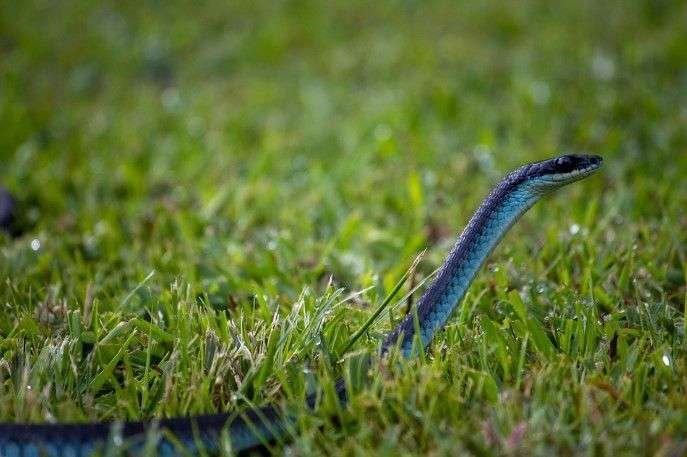
Blue Racer Snake is a nonvenomous species known for its beautiful blue color. The species is quite long, and their skin is mesmerizing blue with a paler blue ventral side.
They like to stay away from humans and take shelter in places with the least human activities. Though they are fierce predators of rodents and songbirds, and even snakes, they are vulnerable to birds of prey.
- Scientific name: Coluber constrictor foxii
- Size: 90 – 152 centimeters
- Location: Illinois, Indiana, Iowa, Michigan, Ohio and Wisconsin in the United States, and Pelee Island in Ontario, Canada
4) Rock Rattlesnake
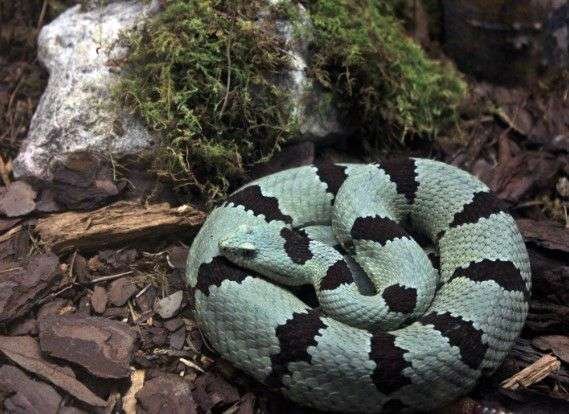
Rock Rattlesnake is a pit viper species and is venomous. This species is pretty small in size and has a gray-blue skin coloration with parallel dark diamond-shaped stripes all over the body.
Its skin color helps it camouflage in its rocky surroundings. The snakes tend to rattle their tails under perceived threat, though they are pretty harmless. They will, however, strike to bite if touched.
- Common Name: Blue Rattlesnake, Eastern Rock Rattlesnake, Green Rattlesnake, Little Green Rattlesnake, Pink Rattlesnake, Rock Rattlesnake, Texas Rock Rattlesnake, White Rattlesnake
- Scientific name: Crotalus lepidus
- Size: 81.3 centimeters (32 inches)
- Location: Arizona, southern New Mexico, southwestern Texas, northern Central Mexico
5) Eastern Indigo Snake
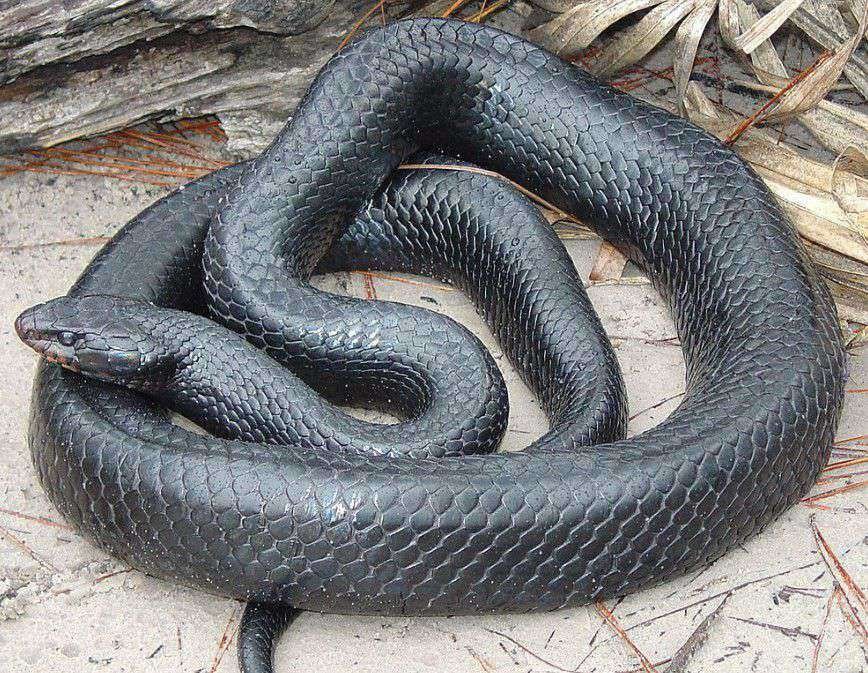
The Eastern Indigo Snakes are a species of long snakes with blue-black skin leading their name. They are nonvenomous and found only in the southeastern part of the USA.
They have a defense mechanism where they flatten their neck, hisses, and vibrates their tail under perceived threat, though they rarely bite. Due to habitat loss, this species is currently in the Threatened category of ESA.
- Common Name: Indigo Snake, Blue Indigo Snake, Black Snake, Blue Gopher Snake, and Blue Bull Snake
- Scientific name: Drymarchon couperi
- Size: males- 120 – 236 centimeters (3.9 – 7.7 feet), females- 1.1 – 2 meters (3.6 – 6.6 feet)
- Location: South Carolina, Florida, Alabama, Mississippi
6) Side-Striped Palm Pit Viper
Side-Striped Palm Pit Vipers are usually green in color, but there have been few blue side-striped palm pit vipers noticed in nature. The blue snakes have a pale ventral side and multiple white and black dots scattered along the body.
These vipers are a venomous species, but their venom is mild and not lethal, though the bite sure hurts.
- Common Name: Side-Striped Palm Viper, Green Palm Viper, Yellow Lined Palm Viper, Parrot Viper
- Scientific name: Bothriechis lateralis
- Size: 80 – 100 centimeters (31 – 39 inches)
- Location: Costa Rica, western Panama
7) Blue-Lipped Sea Krait
Blue-Lipped Sea Krait is a sea snake found in the Indian and Pacific Oceans. The snakes of this species are slender-bodied and blue in color, with black vertical stripes along the body.
They are also extremely venomous, considered to be ten times more potent than rattlesnake venom. A very special behavior of this species is that they warm up in the burrows of the Oceania native Wedge-Tailed Shearwater birds.
- Common Name: Blue-Banded Sea Krait, Common Sea Krait
- Scientific name: Laticauda laticaudata
- Size: males- 96.5 – 119 centimeters (38 – 47 inches), females- 76 – 89 centimeters (30 – 35 inches)
- Location: Australia, Bay of Bengal, Fiji, Fujian, Indonesia, Japan, coast of Malay Peninsula, Melanesia, New Caledonia, New Guinea, Palau, Polynesia, Philippines, Solomon Islands, Taiwan, Timor-Leste, Vanuatu
8) High Blue Green Tree Python
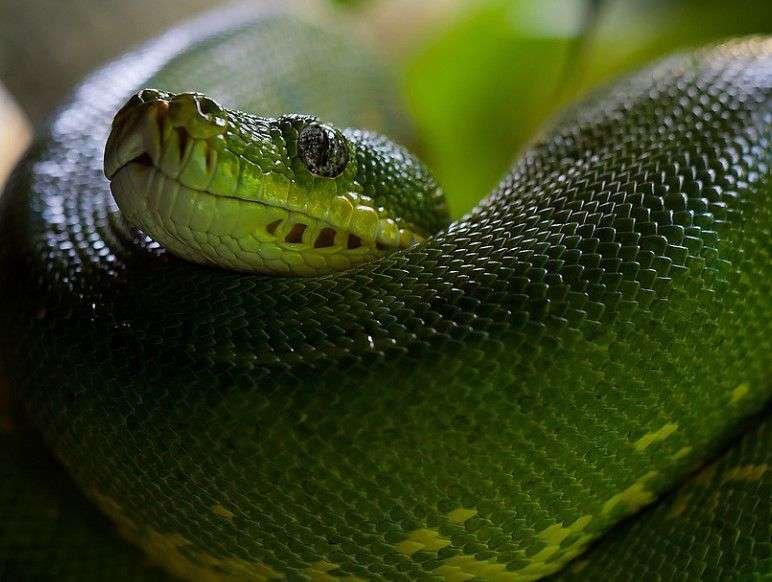
High Blue Green Tree Python is a species very popular as a pet. They are a species of nonvenomous python. They have a very particular way of resting on branches: coiling its whole body around the branch and resting its head in the center.
Although these snakes are generally green, there’ve been a few maroons and blue tree pythons found. The blue tree python is particularly very beautiful and also very expensive.
- Common Name: Green Tree Python
- Scientific name: Morelia viridis
- Size: 150 – 180 centimeters (4.9 – 5.9 feet)
- Location: Indonesia, Australia, New Guinea
9) Blue Pit Viper
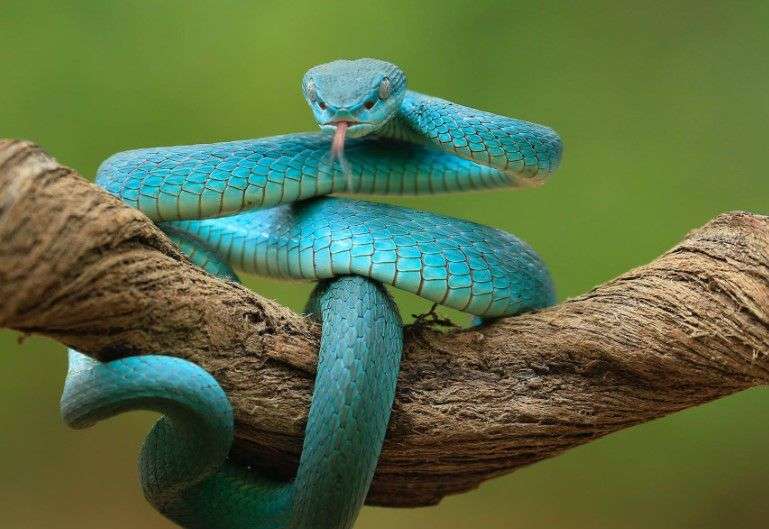
Blue Pit Viper is an unusually beautiful snake that became an internet sensation in 2020 after being seen wrapped around a rose. Its color is a gorgeous light blue with a pale-colored belly.
Blue Pit Viper is actually a White-lipped Pit Viper caused by a mutation, resulting in its unnatural color. Like all vipers, they are venomous, and their venom is extremely potent and lethal to humans.
- Common Name: Blue Viper, Indonesian Pit Viper, Sunda White-Lipped Pit Viper, Lesser Sunda Islands Pit Viper
- Scientific name: Trimeresurus insularis
- Size: 120 – 150 centimeters (4 – 5 feet)
- Location: East Timor, and eastern Java, Adonara, Alor, Bali, Flores, Komodo, Lombok, Padar, Rinca, Romang, Roti, Sumba, Sumbawa, and Wetar in Indonesia
10) San Francisco Garter Snake
San Francisco Garter Snake is a subspecies of the Common Garter Snakes and is considered to be an endangered subspecies. They are endemic to some very small parts of California.
This subspecies of snake is extremely vibrant and gorgeous to look at. They have multiple colorful stripes along their bodies, blue-green, black, and red. They are nonvenomous and harmless to humans.
- Scientific name: Thamnophis sirtalis tetrataenia
- Size: 46 – 140 centimeters (18 – 55 inches)
- Location: San Francisco Peninsula, Santa Cruz Mountains
List of the Rest of Blue and Black Snakes
-
11) California Garter Snake
-
12) Ornate Reef Sea Snake*
-
13) Malabar Pit Viper*
-
14) Blue Phase Common Tree Snake
-
15) Iridescent Shieldtail
-
16) Formosan Odd Scaled Snake
-
17) Yellow Lipped Sea Krait*
-
18) Baron’s Green Racer Snake*
-
19) Eyelash Viper
-
20) Blue-Striped Garter Snake
-
21) Spiny Bush Viper*
-
22) Blue Brahminy Blind Snake
-
23) Rainbow Snake
-
24) Northern Mojave Rattlesnake*
-
25) Blue-Bellied Kukri Snake
-
26) Boomslang Snake*
-
27) Pygmy Rattlesnake*
-
28) Rough Green Snake
-
29) Twin-Spotted Rattlesnake*
-
30) Western Natal Green Snake
(*) indicates venomous
With this, we conclude this topic of 30+ interesting blue and black snakes. Let us know what you thought about this particular piece and if you liked it, don’t forget to check our similar articles.
Also Read:
Anamika has a fascination with all living things. Being a Zoology student, she loves to know new interesting things about animals. She’s also a very keen fan of manga and anime. Writing is her passion, and writing about her favorite things is her boost of serotonin.
